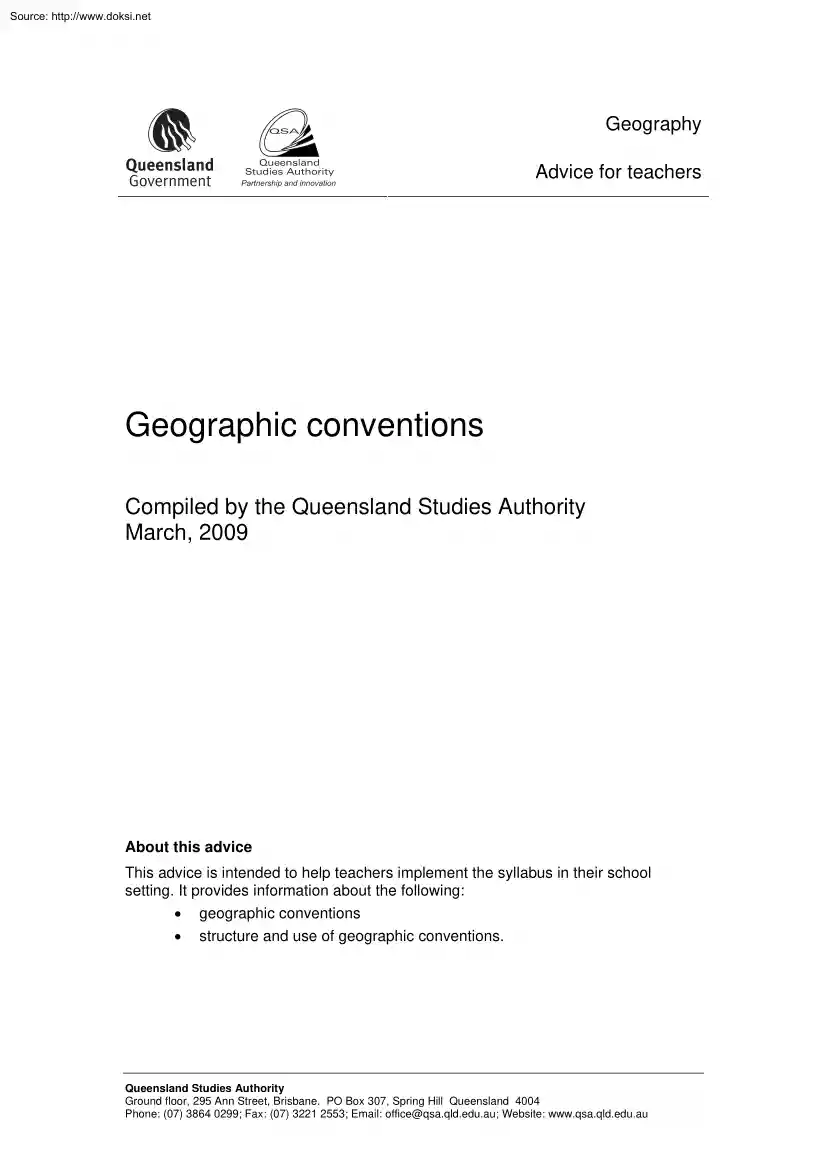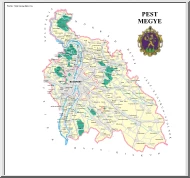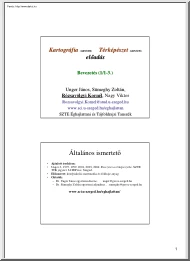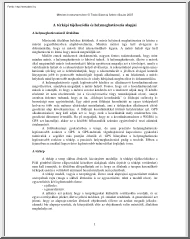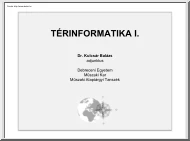Datasheet
Year, pagecount:2009, 9 page(s)
Language:English
Downloads:2
Uploaded:January 18, 2018
Size:855 KB
Institution:
-
Comments:
Attachment:-
Download in PDF:Please log in!
Comments
No comments yet. You can be the first!Most popular documents in this category
Content extract
Source: http://www.doksinet Geography Advice for teachers Geographic conventions Compiled by the Queensland Studies Authority March, 2009 About this advice This advice is intended to help teachers implement the syllabus in their school setting. It provides information about the following: geographic conventions structure and use of geographic conventions. Queensland Studies Authority Ground floor, 295 Ann Street, Brisbane. PO Box 307, Spring Hill Queensland 4004 Phone: (07) 3864 0299; Fax: (07) 3221 2553; Email: office@qsa.qldeduau; Website: wwwqsaqldeduau Source: http://www.doksinet Geographic conventions It is important that students know and understand the accepted conventions of the various modes of representing geographic information. Maps As a representation of the Earth’s surface (or part of it), maps can vary from simple location drawings to multi-layered GIS projects. The following conventions relate to all maps regardless of size or purpose. Border
Positions the map within the white space of the page Assists to define the extent of the map Orientation As either: north point latitude and longitude Legend (or key) List of the symbols and colours used: usually located in the bottom left- or right-hand corner uses shading when boxes are used are no more than 1 cm2 is titled and, if appropriate, incorporates a description of the symbolisation used on the map, e.g Population Density: People per square kilometre uses accepted symbolisation, e.g towns, urban areas, railways, national parks Title Defines the map’s location and its purpose Written in UPPER CASE Scale As either line ratio Source Where possible the source of the map should be acknowledged using an accepted referencing system such as author–date Avoid cutting and pasting maps from the internet that fail to follow these basic conventions. Hand-drawn maps should be completed in black ink and pencil (where shading is
used). Shading should resemble the feature drawn, eg streams in blue, vegetation in green. When maps are constructed under test conditions using Geographic Information Systems (e.g Practical Exercises) students must have individual computer access. Maps used in reports should be referred to as figures and numbered accordingly, e.g FIGURE 1: THE LOCATION OF CHATHAM ISLAND RELATIVE TO NEW ZEALAND AND AUSTRALIA Queensland Studies Authority Ground floor, 295 Ann Street, Brisbane. PO Box 307, Spring Hill Queensland 4004 Phone: (07) 3864 0299; Fax: (07) 3221 2553; Email: office@qsa.qldeduau; Website: wwwqsaqldeduau Source: http://www.doksinet FIGURE 1: THE LOCATION OF CHATHAM ISLAND RELATIVE TO NEW ZEALAND AND AUSTRALIA Title including numbering Border Legend (key) Scale Source Source: Topographic Map of Chatham Islands, NASA Shuttle Radar Topography Mission, Wikipedia Commons, accessed 27 March 2009, <http://en.wikipediaorg/wiki/File:ChathamIslands map topo ensvg> in
the public domain Specialised maps Choropleth maps should show the following additional features: Shading close to monochromatic (e.g yellow/orange/red/brown) in pencil if hand drawn Colours lighter for lower categories, darker for higher categories Legend title incorporating a description of data, e.g Life expectancy by region Legend boxes (ruler-drawn boxes no more than 1 cm² each) determination of categories: 3–6 categories (depending on number of items in data set. Use data that will not take too much time to map) Categories do not need to have same value range but should be based on appropriate groupings All categories should be represented on map Categories should be listed in descending order (darkest colour at the top) Queensland Studies Authority Ground floor, 295 Ann Street, Brisbane. PO Box 307, Spring Hill Queensland 4004 Phone: (07) 3864 0299; Fax: (07) 3221 2553; Email: office@qsa.qldeduau; Website: wwwqsaqldeduau Orientation
(latitude and longitude or north point) Source: http://www.doksinet Title including numbering FIGURE 2: LIFE EXPECTANCY IN SWEDEN BY REGION Monochromatic shading Border Legend has: Life expectancy (years) Title No more than 6 categories Appropriate groupings Orientation (north point) N Source Scale: not available Source: Life Expectancy in Sweden, Wikipedia Commons, accessed 20 April 2009, <http://commons.wikimediaorg/wiki/File:Life expectancy in Sweden.png> in the public domain Isoline maps (contours, isobars, isohyets, isotherms) should show the following additional features: Determination of intervals sufficient to highlight patterns and show variation Satellite images The following conventions relate to the use of satellite images: Border Orientation Title in upper case including figure number, e.g FIGURE 3: LANDSAT IMAGE OF EVANSVILLE, INDIANA AND NORTHERN KENTUCKY AFTER A TORNADO Scale (if possible) Source using
accepted referencing system and date of download Possible annotations, e.g Note the pale interrupted stripe across the image showing the track the tornado made as it moved from south-west to north-east When satellite images are included in a report they must be referred to in text, e.g Figure 3 highlights the linear spatial impact of the tornado hazard and the difficulty in predicting its path. Queensland Studies Authority Ground floor, 295 Ann Street, Brisbane. PO Box 307, Spring Hill Queensland 4004 Phone: (07) 3864 0299; Fax: (07) 3221 2553; Email: office@qsa.qldeduau; Website: wwwqsaqldeduau Source: http://www.doksinet FIGURE 3: LANDSAT IMAGE OF EVANSVILLE, INDIANA AND NORTHERN KENTUCKY AFTER A TORNADO Note the pale, interrupted stripe across the image showing the track the tornado made as it moved from south-west to north-east. Annotations Border Orientation (north point) & scale Source: Tornado Track Across Indiana and Kentucky, NASA’s Earth Observatory,
accessed 27 March 2009 <http://earthobservatory.nasagov/IOTD/viewphp?id=6037>, in the public domain with attribution Source Queensland Studies Authority Ground floor, 295 Ann Street, Brisbane. PO Box 307, Spring Hill Queensland 4004 Phone: (07) 3864 0299; Fax: (07) 3221 2553; Email: office@qsa.qldeduau; Website: wwwqsaqldeduau Source: http://www.doksinet Photographs (aerial and ground) The following conventions relate to the use of photographs: Border Title in upper case including figure number, e.g FIGURE 4: AN OBLIQUE AERIAL PHOTOGRAPH OF THE INNER CITY SUBURB OF KEDRON Scale (if possible). Ground photos taken at close range (such as sand dune erosion or soil profiles) may include some indication of scale, such as a ruler or object Source using accepted referencing system and date of download Possible annotations, e.g This photograph shows the area through which the proposed Brisbane Airlink will pass. The project will include Australia’s longest
road tunnel and a flyover at an estimated cost of $4.6 billion FIGURE 4: AN OBLIQUE AERIAL PHOTOGRAPH OF THE INNER CITY SUBURB OF KEDRON This photograph shows the area through which the proposed Brisbane Airlink will pass. The project will include Australia’s longest road tunnel and a flyover at an estimated cost of $4.8 billion Title (including numbering) Annotations Border Source: Old Haunt: Brisbane photo taken from a hot air balloon, photo from Cyron Ray Macey’s flickrstream accessed 27 March 2009, Creative Commons: Attribution-Noncommercial 2.0 Generic licensed When photographs are included in a report they must be referred to in text. Avoid cutting and pasting photographs from the internet that fail to follow these basic conventions. Queensland Studies Authority Ground floor, 295 Ann Street, Brisbane. PO Box 307, Spring Hill Queensland 4004 Phone: (07) 3864 0299; Fax: (07) 3221 2553; Email: office@qsa.qldeduau; Website: wwwqsaqldeduau Source:
http://www.doksinet Diagrams Diagrams include cross-sections, transects, line drawings, flow charts and graphic organisers. The following conventions relate to the use of diagrams: Border Title in upper case including figure number Labelling of key features of interest Shading (using pencil if hand drawn) Scale (if possible/applicable) Source Possible annotations When diagrams are included in a report they must be referred to in text. Avoid cutting and pasting diagrams from the internet that fail to follow these basic conventions. Graphs The following conventions relate to the use of graphs: Border Title in upper case incorporating a description of the data and including a figure number, e.g FIGURE 2: HOUSEHOLD TYPE INNER NORTH-EASTERN SUBURBS OF BRISBANE Horizontal axis labelled with numbers and words Vertical axis labelled with numbers and words Determination of scale/intervals such that patterns or trends can be determined
without exaggeration Legend/key where segments or sectors are coloured, as in compound and composite bar graphs and pie graphs Source and date of download if applicable Possible annotations When graphs are included in a report they must be referred to in text. Queensland Studies Authority Ground floor, 295 Ann Street, Brisbane. PO Box 307, Spring Hill Queensland 4004 Phone: (07) 3864 0299; Fax: (07) 3221 2553; Email: office@qsa.qldeduau; Website: wwwqsaqldeduau Source: http://www.doksinet Border Title and number of figure. Title gives a brief description of data. FIGURE 2 HOUSEHOLD TYPE INNER NORTH-EASTERN SUBURBS Vertical (Y) Axis clearly labelled Percentage 100% 80% Group share household 60% Lone person household 40% Key Family household 20% in W oo lo ow Nu nd ah He nd ra Lu tw yc he on Ha m i lt yf ie ld Cl a As co t Scale appropriate to determine patterns Al bi on 0% Horizontal (X) Axis clearly labelled Surburb Source: A Statistical
Portrait of Brisbane: Inner North East Region Households, Brisbane City Council 2005, accessed 27 March 2009, <http://svc189.bne146vserver-webcom/statistical portrait/inner north east/households/ Brisbane City Council 2005>. Specialised graphs Source of data Age-sex pyramids (population pyramids) should show the following additional features: Title in upper case incorporating place and year of data Horizontal axis separating females (right-hand side) and males (left-hand side) Vertical axis using five-year intervals Climate graphs should show the following additional features: Title in upper case stating name and location (latitude and longitude) Horizontal axis showing the months of the year Right vertical axis showing rainfall in millimetres Precipitation shown by 12 vertical columns (without gaps) at the bottom of the graph Left vertical axis showing temperature in degrees celsius Temperature shown by a smooth curved line
Determination of scale/intervals such that patterns or trends can be determined without exaggeration Scatter graphs should show the following additional features: Horizontal axis independent variable (e.g income) Vertical axis dependant variable (e.g life expectancy) When graphs are included in a report they must be referred to in text. When graphs are constructed under test conditions using computers (e.g Practical Exercises) students must have individual computer access. Queensland Studies Authority Ground floor, 295 Ann Street, Brisbane. PO Box 307, Spring Hill Queensland 4004 Phone: (07) 3864 0299; Fax: (07) 3221 2553; Email: office@qsa.qldeduau; Website: wwwqsaqldeduau Source: http://www.doksinet Tables of data The following conventions relate to the use of tables of data: Tables should be numbered Title in upper case incorporating place and description of data, e.g TABLE 2: GHANA’S COCOA PRODUCTION (TONNES) 1979–2003 Source using accepted
referencing system and date of download Tables are not figures When tables are included in a report they must be referred to in text TABLE 2: GHANA’S COCOA PRODUCTION (TONNES) 1979–2003 Source: Queensland Studies Authority, Senior Geography External Examination 2007, QSA, Brisbane, accessed 27 March 2009 <www.qsaqldeduau/downloads/assessment/see geography 07 p1 rbpdf> All figures and tables should be well presented, neat and convey information with clarity and accuracy. There should be no ambiguity Queensland Studies Authority Ground floor, 295 Ann Street, Brisbane. PO Box 307, Spring Hill Queensland 4004 Phone: (07) 3864 0299; Fax: (07) 3221 2553; Email: office@qsa.qldeduau; Website: wwwqsaqldeduau
Positions the map within the white space of the page Assists to define the extent of the map Orientation As either: north point latitude and longitude Legend (or key) List of the symbols and colours used: usually located in the bottom left- or right-hand corner uses shading when boxes are used are no more than 1 cm2 is titled and, if appropriate, incorporates a description of the symbolisation used on the map, e.g Population Density: People per square kilometre uses accepted symbolisation, e.g towns, urban areas, railways, national parks Title Defines the map’s location and its purpose Written in UPPER CASE Scale As either line ratio Source Where possible the source of the map should be acknowledged using an accepted referencing system such as author–date Avoid cutting and pasting maps from the internet that fail to follow these basic conventions. Hand-drawn maps should be completed in black ink and pencil (where shading is
used). Shading should resemble the feature drawn, eg streams in blue, vegetation in green. When maps are constructed under test conditions using Geographic Information Systems (e.g Practical Exercises) students must have individual computer access. Maps used in reports should be referred to as figures and numbered accordingly, e.g FIGURE 1: THE LOCATION OF CHATHAM ISLAND RELATIVE TO NEW ZEALAND AND AUSTRALIA Queensland Studies Authority Ground floor, 295 Ann Street, Brisbane. PO Box 307, Spring Hill Queensland 4004 Phone: (07) 3864 0299; Fax: (07) 3221 2553; Email: office@qsa.qldeduau; Website: wwwqsaqldeduau Source: http://www.doksinet FIGURE 1: THE LOCATION OF CHATHAM ISLAND RELATIVE TO NEW ZEALAND AND AUSTRALIA Title including numbering Border Legend (key) Scale Source Source: Topographic Map of Chatham Islands, NASA Shuttle Radar Topography Mission, Wikipedia Commons, accessed 27 March 2009, <http://en.wikipediaorg/wiki/File:ChathamIslands map topo ensvg> in
the public domain Specialised maps Choropleth maps should show the following additional features: Shading close to monochromatic (e.g yellow/orange/red/brown) in pencil if hand drawn Colours lighter for lower categories, darker for higher categories Legend title incorporating a description of data, e.g Life expectancy by region Legend boxes (ruler-drawn boxes no more than 1 cm² each) determination of categories: 3–6 categories (depending on number of items in data set. Use data that will not take too much time to map) Categories do not need to have same value range but should be based on appropriate groupings All categories should be represented on map Categories should be listed in descending order (darkest colour at the top) Queensland Studies Authority Ground floor, 295 Ann Street, Brisbane. PO Box 307, Spring Hill Queensland 4004 Phone: (07) 3864 0299; Fax: (07) 3221 2553; Email: office@qsa.qldeduau; Website: wwwqsaqldeduau Orientation
(latitude and longitude or north point) Source: http://www.doksinet Title including numbering FIGURE 2: LIFE EXPECTANCY IN SWEDEN BY REGION Monochromatic shading Border Legend has: Life expectancy (years) Title No more than 6 categories Appropriate groupings Orientation (north point) N Source Scale: not available Source: Life Expectancy in Sweden, Wikipedia Commons, accessed 20 April 2009, <http://commons.wikimediaorg/wiki/File:Life expectancy in Sweden.png> in the public domain Isoline maps (contours, isobars, isohyets, isotherms) should show the following additional features: Determination of intervals sufficient to highlight patterns and show variation Satellite images The following conventions relate to the use of satellite images: Border Orientation Title in upper case including figure number, e.g FIGURE 3: LANDSAT IMAGE OF EVANSVILLE, INDIANA AND NORTHERN KENTUCKY AFTER A TORNADO Scale (if possible) Source using
accepted referencing system and date of download Possible annotations, e.g Note the pale interrupted stripe across the image showing the track the tornado made as it moved from south-west to north-east When satellite images are included in a report they must be referred to in text, e.g Figure 3 highlights the linear spatial impact of the tornado hazard and the difficulty in predicting its path. Queensland Studies Authority Ground floor, 295 Ann Street, Brisbane. PO Box 307, Spring Hill Queensland 4004 Phone: (07) 3864 0299; Fax: (07) 3221 2553; Email: office@qsa.qldeduau; Website: wwwqsaqldeduau Source: http://www.doksinet FIGURE 3: LANDSAT IMAGE OF EVANSVILLE, INDIANA AND NORTHERN KENTUCKY AFTER A TORNADO Note the pale, interrupted stripe across the image showing the track the tornado made as it moved from south-west to north-east. Annotations Border Orientation (north point) & scale Source: Tornado Track Across Indiana and Kentucky, NASA’s Earth Observatory,
accessed 27 March 2009 <http://earthobservatory.nasagov/IOTD/viewphp?id=6037>, in the public domain with attribution Source Queensland Studies Authority Ground floor, 295 Ann Street, Brisbane. PO Box 307, Spring Hill Queensland 4004 Phone: (07) 3864 0299; Fax: (07) 3221 2553; Email: office@qsa.qldeduau; Website: wwwqsaqldeduau Source: http://www.doksinet Photographs (aerial and ground) The following conventions relate to the use of photographs: Border Title in upper case including figure number, e.g FIGURE 4: AN OBLIQUE AERIAL PHOTOGRAPH OF THE INNER CITY SUBURB OF KEDRON Scale (if possible). Ground photos taken at close range (such as sand dune erosion or soil profiles) may include some indication of scale, such as a ruler or object Source using accepted referencing system and date of download Possible annotations, e.g This photograph shows the area through which the proposed Brisbane Airlink will pass. The project will include Australia’s longest
road tunnel and a flyover at an estimated cost of $4.6 billion FIGURE 4: AN OBLIQUE AERIAL PHOTOGRAPH OF THE INNER CITY SUBURB OF KEDRON This photograph shows the area through which the proposed Brisbane Airlink will pass. The project will include Australia’s longest road tunnel and a flyover at an estimated cost of $4.8 billion Title (including numbering) Annotations Border Source: Old Haunt: Brisbane photo taken from a hot air balloon, photo from Cyron Ray Macey’s flickrstream accessed 27 March 2009, Creative Commons: Attribution-Noncommercial 2.0 Generic licensed When photographs are included in a report they must be referred to in text. Avoid cutting and pasting photographs from the internet that fail to follow these basic conventions. Queensland Studies Authority Ground floor, 295 Ann Street, Brisbane. PO Box 307, Spring Hill Queensland 4004 Phone: (07) 3864 0299; Fax: (07) 3221 2553; Email: office@qsa.qldeduau; Website: wwwqsaqldeduau Source:
http://www.doksinet Diagrams Diagrams include cross-sections, transects, line drawings, flow charts and graphic organisers. The following conventions relate to the use of diagrams: Border Title in upper case including figure number Labelling of key features of interest Shading (using pencil if hand drawn) Scale (if possible/applicable) Source Possible annotations When diagrams are included in a report they must be referred to in text. Avoid cutting and pasting diagrams from the internet that fail to follow these basic conventions. Graphs The following conventions relate to the use of graphs: Border Title in upper case incorporating a description of the data and including a figure number, e.g FIGURE 2: HOUSEHOLD TYPE INNER NORTH-EASTERN SUBURBS OF BRISBANE Horizontal axis labelled with numbers and words Vertical axis labelled with numbers and words Determination of scale/intervals such that patterns or trends can be determined
without exaggeration Legend/key where segments or sectors are coloured, as in compound and composite bar graphs and pie graphs Source and date of download if applicable Possible annotations When graphs are included in a report they must be referred to in text. Queensland Studies Authority Ground floor, 295 Ann Street, Brisbane. PO Box 307, Spring Hill Queensland 4004 Phone: (07) 3864 0299; Fax: (07) 3221 2553; Email: office@qsa.qldeduau; Website: wwwqsaqldeduau Source: http://www.doksinet Border Title and number of figure. Title gives a brief description of data. FIGURE 2 HOUSEHOLD TYPE INNER NORTH-EASTERN SUBURBS Vertical (Y) Axis clearly labelled Percentage 100% 80% Group share household 60% Lone person household 40% Key Family household 20% in W oo lo ow Nu nd ah He nd ra Lu tw yc he on Ha m i lt yf ie ld Cl a As co t Scale appropriate to determine patterns Al bi on 0% Horizontal (X) Axis clearly labelled Surburb Source: A Statistical
Portrait of Brisbane: Inner North East Region Households, Brisbane City Council 2005, accessed 27 March 2009, <http://svc189.bne146vserver-webcom/statistical portrait/inner north east/households/ Brisbane City Council 2005>. Specialised graphs Source of data Age-sex pyramids (population pyramids) should show the following additional features: Title in upper case incorporating place and year of data Horizontal axis separating females (right-hand side) and males (left-hand side) Vertical axis using five-year intervals Climate graphs should show the following additional features: Title in upper case stating name and location (latitude and longitude) Horizontal axis showing the months of the year Right vertical axis showing rainfall in millimetres Precipitation shown by 12 vertical columns (without gaps) at the bottom of the graph Left vertical axis showing temperature in degrees celsius Temperature shown by a smooth curved line
Determination of scale/intervals such that patterns or trends can be determined without exaggeration Scatter graphs should show the following additional features: Horizontal axis independent variable (e.g income) Vertical axis dependant variable (e.g life expectancy) When graphs are included in a report they must be referred to in text. When graphs are constructed under test conditions using computers (e.g Practical Exercises) students must have individual computer access. Queensland Studies Authority Ground floor, 295 Ann Street, Brisbane. PO Box 307, Spring Hill Queensland 4004 Phone: (07) 3864 0299; Fax: (07) 3221 2553; Email: office@qsa.qldeduau; Website: wwwqsaqldeduau Source: http://www.doksinet Tables of data The following conventions relate to the use of tables of data: Tables should be numbered Title in upper case incorporating place and description of data, e.g TABLE 2: GHANA’S COCOA PRODUCTION (TONNES) 1979–2003 Source using accepted
referencing system and date of download Tables are not figures When tables are included in a report they must be referred to in text TABLE 2: GHANA’S COCOA PRODUCTION (TONNES) 1979–2003 Source: Queensland Studies Authority, Senior Geography External Examination 2007, QSA, Brisbane, accessed 27 March 2009 <www.qsaqldeduau/downloads/assessment/see geography 07 p1 rbpdf> All figures and tables should be well presented, neat and convey information with clarity and accuracy. There should be no ambiguity Queensland Studies Authority Ground floor, 295 Ann Street, Brisbane. PO Box 307, Spring Hill Queensland 4004 Phone: (07) 3864 0299; Fax: (07) 3221 2553; Email: office@qsa.qldeduau; Website: wwwqsaqldeduau
